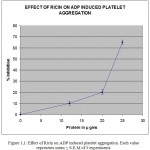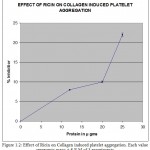Manuscript accepted on : September 16, 2010
Published online on: 28-12-2016
Role of Ricin in Platelet Aggregation
Sumasridhar1 and L. M. S. Rudrammaji2
1Department of Bio-chemistry, Dayananda Sagar College of Dental Sciences, Kumarswamy layout, Bangalore - 560 078 India.
2Pretoria, South Africa.
ABSTRACT: Ricin is a Ribosome Inactivating Protein from the seeds of Ricinus communis. The long time interest in this protein is due to the wide medical and therapeutical applications. It acts as a cytotoxic protein which has implications in cancer therapy. In this study we have established the role of ricin as an inhibitor of platelet aggregation. Platelet aggregation studies were done by turbidometric method and platelet inducing factors like ADP and collagen were used. Increasing concentrations of ricin were used on ADP induced and collagen induced platelets separately, to understand the role of ricin in platelet aggregation. Maximum inhibition was seen at 25μg/ml concentration of ricin.
KEYWORDS: Ricin; ADP; collagen; ribosome-inactivating protein
Download this article as:| Copy the following to cite this article: Sumasridhar, Rudrammaji L. M. S. Role of Ricin in Platelet Aggregation. Biosci Biotech Res Asia 2010;7(2) |
| Copy the following to cite this URL: Sumasridhar, Rudrammaji L. M. S. Role of Ricin in Platelet Aggregation. Biosci Biotech Res Asia 2010;7(2). Available from:https://www.biotech-asia.org/?p=9785 |
Introduction
Ricin toxin is a heterodimeric 62Kda glycoprotein produced in the seeds of Ricinus communis. (Barbieri et al 1993). This protein is capable of inactivating ribosomes and thereby called Ribosome-Inactivating Protein (RIP). (Hartley et al 1996; Olsnes &Pihl 1973; Olsnes et al 1994). This RIP brings about halt in protein synthesis leading to cell death. Hence it has therapeutical application as antitumour protein (Nicolson GL, Blaustein J, 1972).
Platelet aggregation can be initiated invitro by various agonists like ADP, collagen, epinephrine etc. It is a multistep process. The analysis can be made using a turbidometer, by recording the tracing of changes in light transmission. During the initial phase of platelet aggregation following the addition of agonist like ADP or collagen, there is change in the shape of platelets which can be detected by a decrease in light transmission.(Kini & Evans H.J, 1990)
In the second stage, there is increase in light transmission as the platelets aggregate and clear the way for the light to be transmitted through a platelet suspension. ADP and collagen induces platelet aggregation..
Materials and Methods
ADP, collagen were purchased from Sigma chemicals Co. St Louis USA. Human blood samples were from healthy volunteers. All the chemicals used were of analytical grade. Ricin was purified in our laboratory.
Isolation of platelets
Human blood was collected from the vein of healthy non-smoker volunteers, who were not on any medication for at least the previous 2 weeks. Nine volumes of blood was collected into one volume of acid citrate dextrose (93mM sodium citrate, 7mM citric acid and 140mM glucose, pH 6.5). and immediately centrifuged for 10min at 90Xg at room temp (25°C). The supernatent obtained was collected as Platelet Rich Plasma (PRP). Homologous platelet poor plasma (PPP) was prepared by recentrifugation of the remaining blood for 15min at 500Xg at room temp. The platelet concertration of PRP was adjusted with PPP to 2,25,000±25,000 platelets/ml. The PRP was kept at 37°C and was used within 2hrs after preparation. All the above preparations were carried out using plastic or siliconized glassware.
For platelet aggregation studies, the turbidometrical method (Born 1962) was followed using a chronology dual channel aggregometer. The recorder, recorded the light transmission as a function of time. When platelet aggregating agent was added to Platelet Rich Plasma (PRP), the platelets clumps and PRP becomes progressively clear showing increase in light transmission through it. Aliquotes of PRP (0.45 ml) were placed in a siliconized glass cuvette in the aggregometer, positioned on a thermostat block at 37°C and continuosly stirred by means of a small metal stirbar in the cuvette and a rotating magnet beneath. The turbidity of the PRP was constantly measured by recording transmission of a light beam directed through it and is recorded as change in voltage on the recorder. As platelets aggregate in response to an added agonist, light transmission increases progressively, producing an “Aggregation trace” on the recorder. This aggregation trace is the plot of light transmission between PRP and PPP baseline which represent 0% and 100% aggregation respectively. This curve is plotted as a function of time on a linear scale. For concentration dependent platelet aggregation studies, different concentration (0-24mg/ml) of Ricin was incubated separately with PRP with constant stirring for 2min. aliquots of PRP were pre-incubated with Ricin. Platelet aggregation of treated PRP was then initiated by the addition of ADP(76mM), and collagen (2mg/ml) separately. Percent inhibition of aggregation was calculated assuming the value of control(without any aggregation inhibitor) to be 100%.
Results and Discussion
Effect of Ricin on platelet aggregation was determined using PRP sample. Ricin inhibits platelet aggregation induced by each of the agonists ADP(Fig1.1) and collagen(Fig 1.2). The inhibition was dose dependent with both the agonist induced platelet aggregation. Maximun inhibition was seen at 25mg/ml concentration.
 |
Figure 1:Effect of Ricin on ADP induced platelet aggregation. Each value represents mean + S.E.M of 3 experiments.
|
 |
Figure 2:Effect of Ricin on Collagen induced platelet aggregation. Each value represents mean + S.E.M of 3 experiments.
|
Platelet aggregation is inducd by large no of physiological agents such as ADP, seratonin, epinephrine, Collagen etc. The platelets interact through a specific receptor mechanism which mediate shape change aggregation and release reactions.(Kini & Evans H.J, 1990). In the present investigation the effect of Ricin on platelet aggregation proved ricin to be an inhibitor of platelet aggregation.
Some naturally occurring toxins have various pharmacological importance. Some of the toxins from snake venom for ex Agkistrodon acutus PLA2 and Agkistrodon halys PLA2 inhibit platelet aggregation.(Chen and Chen, 1989., Ouyang& Huang (1986)., Huan G and Leecy 1984) .
This pharmacological property of Ricin as an inhibitor of platelet aggregation can be further exploited in the development of prototypes of a new pharmaceutical agents. Understanding the mechanisms will help in the development of new research tools which are useful in characterising platelets aggregation at molecular level.
References
- Barbieri, L., Battelli, M.G. Stirpe, F., 1993. Ribosome inactivating proteins from plants, Biochim. Biophys. Acta 1154, 237 – 282
- Born GVR (1962) “ Qualitative investigation into the aggregation of blood platelets” J Physiol 162: 67-72
- Chaoho Ouyang and Tur-Fu Huang (1986) “Platelet aggregation inhibitors from Agkistrodon acutus snake venom,” Toxicon, 24, 1099-1106.
- Hartley, M.R., Chaddock, J.A., Bonness, M.S. (1996) The structure and function of ribosome – inactivating proteins, Trends Plant Sci 1, 254 – 260
- Kini & Evans H.J (1990) “ Effects of snake venom proteins on blood platelets.” Toxicon 28,1387
- Nicolson GL, Blaustein J, 1972. The interaction of Ricinus communis agglutinin with normal and tumor cell surfaces. Biochem Biophys Acta 266 : 543 – 547
- Olsnes &Pihl A, (1973). “Different biological properties of the two constituent peptide chains of ricin, a toxic protein inhibiting protein synthesis.” Biochemistry 12, 3121-3126.
- Rui-Hong chen and Yuan-chung chen (1989) “Isolation of an acidic phospholipase A2 from the venom of Agkistrodon acutus (five pace snake) and its effect on platelet aggregation. Toxicon, vol 27, 675-682.
- Sjur Olsnes, Karin Refsnes and Alexander Pihl,(1994) “Mechanism of action of the toxic lectins abrin and ricin “Nature,Vol, 249, 627-630
- Zucker. M.B (1989) “ Platelet aggregation measured by photometric method” Meth. Enzymol 169,117

This work is licensed under a Creative Commons Attribution 4.0 International License.





